Reliably Smart
Students learn about the nation’s electric grid system and the ways technology is being used to modernize it.











Students learn about the nation’s electric grid system and the ways technology is being used to modernize it.










Constance Beatty Kankakee, IL
La’Shree Branch Highland, IN
Jim M. Brown Saratoga Springs, NY
Mark Case Randleman, NC
Lisa Cephas Philadelphia, PA
Nina Corley Galveston, TX
Samantha Danielli Vienna, VA
Shannon Donovan Greene, RI
Michelle Garlick Long Grove, IL
Michelle Gay Daphne, AL
Nancy Gi ord Harwich, MA
Erin Gockel Farmington, NM
Robert Griegoliet Naperville, IL
DaNel Hogan Tucson, AZ
Greg Holman Paradise, CA
Barbara Lazar Albuquerque, NM
Robert Lazar Albuquerque, NM
Melissa McDonald Gaithersburg, MD
Paula Miller Philadelphia, PA
Hallie Mills St. Peters, MO
Jennifer MitchellWinterbottom Pottstown, PA
Monette Mottenon Montgomery, AL
Mollie Mukhamedov Port St. Lucie, FL
Cori Nelson Win eld, IL
Don Pruett Jr. Puyallup, WA
Judy Reeves Lake Charles, LA
Libby Robertson Chicago, IL
Amy Schott Raleigh, NC
Tom Spencer Chesapeake, VA
Jennifer Trochez MacLean Los Angeles, CA
Wayne Yonkelowitz Fayetteville, WV
The mission of The NEED Project is to promote an energy conscious and educated society by creating effective networks of students, educators, business, government and community leaders to design and deliver objective, multisided energy education programs.
NEED curriculum is available for reproduction by classroom teachers only. NEED curriculum may only be reproduced for use outside the classroom setting when express written permission is obtained in advance from The NEED Project. Permission for use can be obtained by contacting info@need.org
In support of NEED, the national Teacher Advisory Board (TAB) is dedicated to developing and promoting standardsbased energy curriculum and training.
NEED believes in providing teachers and students with the most recently reported, available, and accurate energy data. Most statistics and data contained within this guide are derived from the U.S. Energy Information Administration. Data is compiled and updated annually where available. Where annual updates are not available, the most current, complete data year available at the time of updates is accessed and printed in NEED materials. To further research energy data, visit the EIA website at www.eia.gov

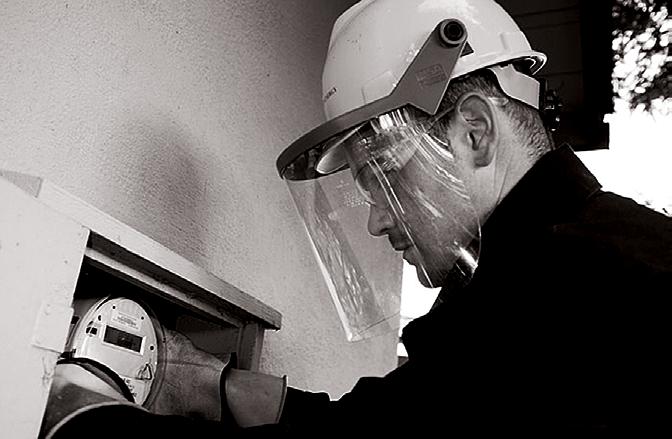
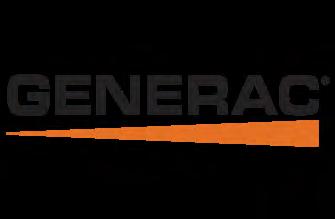
www.NEED.org/educators/curriculum-correlations/
This guide effectively supports many Next Generation Science Standards. This material can satisfy performance expectations, science and engineering practices, disciplinary core ideas, and cross-cutting concepts within your required curriculum. For more details on these correlations, please visit NEED’s curriculum correlations website.
This guide has been correlated to the Common Core State Standards in both language arts and mathematics. These correlations are broken down by grade level and guide title, and can be downloaded as a spreadsheet from the NEED curriculum correlations website.
This guide has been correlated to each state’s individual science standards. These correlations are broken down by grade level and guide title, and can be downloaded as a spreadsheet from the NEED website.

Reliably Smart provides an introduction to energy, electricity, electricity generation and consumption, and ways a modernized grid and smart devices help us manage energy use. Through critical thinking activities and classroom discussion, students develop an understanding of their role in keeping our electric power system running smoothly. The students’ homes and classrooms are used as learning laboratories as they gather and analyze data and prioritize electricity use. Students with smart meter technology in their homes can be encouraged to gather and interpret that information, while aII students can use the data provided in the activities to understand how smart meters and a smart grid system are beneficial. You may find it helpful to familiarize yourself with your local utility’s data reporting mechanisms, whether they be real-time from a smart meter or monthly from a digital or analog meter.
Time
Based on a 50-minute daily class period, this entire unit should be manageable in 1-2 weeks, depending on grade and skill level of the students, as well as which activities are selected for use. The full unit can easily be chopped up into smaller parts, and activities can be selected as needed.
Throughout this module, it is recommended that students record their observations, data, and notes in science notebooks. Student worksheets have been included in this guide. You may choose to use these instead of science notebooks. Or, as appropriate, you may want to make copies of worksheets and have your students glue or tape the copies into their notebooks.
Students will observe and analyze their family’s home energy use over 24 hours. These observations will be helpful when students complete other lessons.
Objectives
Students will be able to identify times when energy use was low and when it was high.
Students will be able to interpret data for maximum and minimum values.
Materials
Energy-Using Devices master, page 11
Home Energy Use worksheet, page 12
2 Preparation
Preview the lesson so you know where students may encounter problems.
Prepare a copy of Energy-Using Devices master for projection.
Prepare 3 copies of the Home Energy Use worksheet for each student.
Provide an alternative source of data for students who may not have the ability to record energy use at home due to alternative living conditions based on living arrangements, access, or safety concerns. Be sensitive to discussion of home environment in these cases.
Elementary, grades 3-5
Intermediate, grades 6-8
Secondary, grades 9-12
: Web Resources
U.S. Energy Information Administration, www.eia.gov
: NEED Online Resources
NEED has many curriculum pieces available to support and extend your Reliably Smart unit. The following guides, and many more, can be downloaded from www.NEED.org/shop:
School Energy Inspectors (3-5)
School Energy Experts (6-8)
School Energy Managers (9-12)
Managing Home Energy Use
Today in Energy
Energy House Village
Plug Loads
Cost of a Thanksgiving Meal
1. Have students read the informational text sections on energy forms, energy sources, and the sectors of the economy. This can be assigned as homework the night before the lesson.
2. Have students stand. Designate one side of the classroom as “we use too much energy” and the other side of the classroom as “we use an appropriate amount of energy.” Have students move to the side of the classroom that they think describes their family. Ask one or two students from each side to justify why they made their choice, and to provide an example or two to support their answers.
3. Have students return to their seats. Introduce the concept of qualitative vs quantitative measurements. Make a T-chart where students can see it with one column labeled “Qualitative” and another “Quantitative.” Ask students to brainstorm words that are qualitative, such as “too many,” “a lot,” or “small.” Ask students for words that are quantitative.
4. Ask students when it is more appropriate to use qualitative than quantitative measurements.
5. Introduce the concepts of power and electricity energy as measured in kilowatt-hours (kWh). Explain that power is an instantaneous measurement, meaning it’s one number taken at one point in time. Explain that a kilowatt-hour is when a device that needs 1,000 watts of power is running for an hour. Good examples are microwaves and hair dryers. In the United States, the average price residential customers pay for electricity is about $0.14/kWh. Tell students the average U.S. price or the price your utility charges.
6. Project the Energy-Using Devices master. Ask students to list the devices that are present in their homes. Ask students to put a mark beside the three they think use the most energy. Then ask students to underline which devices they are able to control.
PART
1. Distribute the Home Energy Use worksheets. Explain their purpose to students. Emphasize that students are not required to stay awake for 24 hours, but if they or their families know something runs overnight, record it at the approximate time it runs. Have students record everything that uses energy, even if it uses natural gas rather than electricity. Even heating systems that run on natural gas have electrical components. Remind students that their family members should also record their activity.
2. Have students gather data for 2 or 3 consecutive days. Then resume the lesson.
PART THREE—DATA ANALYSIS
1. Have students spread their Home Energy Use worksheets in front of them. Ask them if there are things that they did every day at the same time, such as running the dishwasher or watching TV.
2. Ask students why they think demand might be higher at certain times of the day. Tell students electricity demand is often highest in the afternoon and early evening hours, especially on hot summer days. Ask students if there are any activities during this time period that they could shift to other times of the day to reduce that demand.
Download a copy of Plug Loads from the NEED website: https://www.need.org/product/plug-loads-free-pdf-download/. This is a computer spreadsheet-based unit that helps students understand how much running various school devices costs, and can easily be adapted to use data from devices at home.
Use a Kill A Watt™ meter and measure the power consumption of various common devices like a TV, cell phone charger, computer, toaster, microwave, etc. Incorporate this data into the discussion of home energy use or incorporate it into a plug loads lesson about how much it costs to operate various devices. Kill A Watt™ meters can be purchased from online retailers like Amazon, and also directly through NEED. Call the NEED office for pricing and ordering information.
& Background
Smart meters record and provide real-time electricity use from several days prior to the current day. The meter data allows users and families to view, in real time, how their consumption compares to the previous few days and averages out over the year. This data can be useful in helping families to plan for their utility spending, look for patterns, and curb consumption if necessary. In this activity, students will analyze electricity use graphs for a hypothetical family.
Objectives
Students will be able to interpret graphs and understand data trends.
Students will be able to draw conclusions based on data presented in graphs.
Materials
Analyzing Electricity Use student activity, pages 13-14
2 Preparation
Make one copy of the activity for each student.
If you have a smart meter and wish to share your own data for comparison, make copies of your own data for each student or prepare it for projection and discussion.
Procedure
1. Have students read the informational text sections on electricity and its generation and transmission.
2. Preview the activity, telling students they will be analyzing graphs and answering questions.
3. Describe the three basic types of graphs: line, bar, and pie. Explain when each type is used and the type of data each represents. Review independent and dependent variables.
4. Ask students when in a calendar year they would expect electricity use to be greatest, and when they might expect it to be at its least. Ask students to explain their answers. Younger students may need some coaching to start considering monthly weather norms.
5. If applicable, project your own electricity use data for the last 12 months. Ask students when your family used the most electricity and when they used the least. Ask students which variable was independent and which was dependent.
6. Allow students enough time to complete the activity.
7. Discuss the questions with students to ensure they have interpreted the graphs correctly.
Extensions
Have students log into their own families’ utility accounts, if they have their own, to see their own monthly electricity use and make a graph of it. If they do not have their own, you may provide additional samples of your own data or a friend’s to enable access to all.
&Background
Utilities around the country employ different pricing systems. Some simply charge a flat rate per kWh without any kind of tier or time-ofday pricing. Some utilities have a tiered system, charging more as use exceeds certain levels. Some utilities have time-of-day pricing to encourage customers to keep their electricity use down at times when demand is highest. And some utilities use both tiered systems and time-of-day pricing. This activity familiarizes students with both.
Objectives
Students will be able to interpret graphs showing average and cumulative data.
Students will be able to complete calculations based on data presented in graphs.
Materials
Understanding Utility Pricing Mechanisms, pages 15-17
2 Preparation
Make one copy of the activity for each student.
Investigate your local utility’s pricing mechanism.
Procedure
1. Have students read the informational text sections on smart meters, smart grids, and the Internet of Things.
2. Ask students if they know anything that is purchased with tiered pricing. Give examples like drinks at a store or candy bars. Many things are less expensive when purchased in bulk.
3. Explain the tiered pricing and time-of-day rate systems. Ask students why utility companies might want to limit how much power customers use.
4. Allow students enough time to complete the activity.
5. Work through the questions about the graphs to ensure student understanding. Ask students for suggestions that will help families with tiered or time-of-day systems to save money while still accomplishing the tasks they need to do.
&Background
With more Wi-Fi-enabled devices coming to market every month, students are rapidly growing into a life where voice-activated pizza delivery will be commonplace. This elementary-level activity has students identifying the various smart devices that are now common in homes, and asks students to consider how they can help use less energy and make their lives more convenient or comfortable.
Objectives
Students will be able to identify relationships among seemingly unrelated objects.
Students will understand how smart devices can make lives simpler, more secure, and more energy efficient.
Materials
All the Smart Things, pages 18-19
2 Preparation
Make copies of the activity, one per student.
Procedure
1. If they haven’t already, have students read the informational text sections about the Internet of Things. This can be homework or a group reading activity for younger students.
2. Talk through the activity with students. Read the caption that accompanies the drawing while students listen along.
3. Pause while students circle the smart devices in the drawing and list others that are not necessarily pictured but are mentioned in the caption.
4. Help students identify smart devices that can help save energy, as appropriate for their age or ability level.
5. Discuss with students the smart devices they may already have at home and which they would like to have in the future.
6. Students can write about their future smart device inventions, or draw them. Students can also make a quick presentation about their ideas to the class.
Extension
Have students work in small groups to create a fictitious business that will market their smart device invention. Have them create an advertising campaign and submit drawings for a “patent” application that will explain how their device is unique. Students could make video commercials or pitches to advertise their products and show them to the rest of the class, similar to a “Shark Tank” program.
&Background
A hot topic in energy management circles is microgrids. Building-level energy managers of commercial or mixed-use buildings are always looking for ways to reduce the energy consumed in those buildings. One way that has been proposed is to turn a building into its own microgrid. A microgrid is essentially a self-sustained community where electrical power is concerned, generating its electricity for its area without relying on outside generation. Microgrids have already been functional in isolated communities, such as on islands or in very remote villages. These are all examples of standalone power-producing and -consuming communities. This activity introduces this concept and helps students build simple DC circuits to “connect” and “light” their microgrid buildings.
Objectives
Students will be able to explain what a microgrid is.
Students will be able to create a simple DC circuit.
Students will be able to create a parallel DC circuit.
Students will be able to properly connect an LED to a battery.
Materials PER STUDENT OR SMALL GROUP
2 Meters copper tape
2 LEDs
1 Coin battery (3V)
Scissors
Pencil or marker
Microgrid worksheets, pages 20-25
Decide if you will use the pre-printed page for students to build the pre-drawn circuit, or if you will have students construct their own microgrids from the components you provide.
If you decide to have students construct the microgrids, copy page 25 for each student or group. Cut the components apart and put them in an envelope, one envelope per student or group.
Make copies of the microgrid template page (if needed) on page 24.
Make copies of the instruction sheet for each student or group, based on the option.
Gather materials and make them available for students.
Procedure
1. Introduce the activity, explaining microgrids. Ask students how a microgrid is different from the greater electric grid system.
2. Ask students what the advantages would be of having a microgrid in their building or community.
3. Demonstrate the proper method for using the copper tape. It is often easier to peel the backing as the tape is applied to the paper rather than peeling the entire length of paper from the tape at once. When the backing is removed, the copper tape has the tendency to curl.
4. Allow students enough time to build their circuits. Younger students may need more assistance.
Extensions
This activity is a nice introductory or culminating activity for studying circuits and electricity.
This is a great activity to conduct on a parent night.
Spend some time discussing various renewable and nonrenewable sources for electricity generation and how they could be applied in a microgrid.
Tying everything together in this unit, this activity asks students to revisit their family’s energy use, prioritize activities if power is limited, and develop a plan for power outages. Though the calculations and data analysis in this activity are more geared toward older students, younger students can be guided as a large class group through a modified version of the activity with calculations completed for them.
Objectives
Students will be able to calculate the power and electrical energy requirements of various devices found at home.
Students will be able to develop contingency plans based on collected data.
Materials
Calculators (optional)
Kill A Watt™ meters (optional)
Internet access
2 Preparation
If conducting the activity with students below 8th grade, it is recommended that preliminary calculations be made and presented to students rather than having them do the math themselves. Do what is appropriate for the math capabilities of your students.
Students in some living circumstances may not be able to gather data on the devices listed as being in a typical home. Gather this data from devices in your own home and have it ready for those students who might need it. Be sensitive to discussions of home environment in these cases.
Procedure
1. Provide an overview of the activity for students.
2. Students will need to complete the data-gathering portion of the activity at home. Alert parents they may need to assist students in locating the UL plate on appliances. Refrigerators, clothes dryers, dishwashers, and refrigerators often have a sticker somewhere inside the door. Electric ranges have the information on the back, and clothes washers will have this information in various locations. It is important to consider safety when accessing UL plates or labels. Students should use caution and avoid moving heavy appliances or appliances that might be connected to water or gas lines. If students know their manufacturer and model numbers, they can also look up the UL information online.
3. Walk through the data analysis of the activity with students or allow them time to complete it according to their ability level.
4. The first conclusion question asks students to spend a day using as little electricity as possible. They will need to complete this over a weekend or school holiday. You might also want to try this same activity in class, using as little electricity as possible on a school day.
5. Discuss with students how smart meters and a smart grid system are helpful during inclement weather or other circumstances that cause a power outage.
6. Provide students some time to consider strategies they will employ the next time their home loses power for a significant amount of time. This can be done as a whole-class discussion or as an individual writing assignment.
An energy audit conducted by students and their parents can help them learn where they are using more energy than necessary. Student energy audits are outlined in School Energy Inspectors, School Energy Experts, and School Energy Managers, and applications of those lessons in a home setting are described in Managing Home Energy Use. These can be downloaded in PDF format for free by visiting http://need.org/product-category/energy-efficiency-and-conservation/.
Air conditioner
Heating system
Water heater
Pool heat pump
Dishwasher
Washing machine
Clothes dryer
Refrigerator
Freezer
Microwave
Stove/oven
Toaster oven
Coffee maker
Crock pot
Air fryer
Pressure cooker
Porch light
Night light
Flood light
Overhead lights
Closet lights
Floor lamps
Ceiling Fan
Desk lamp
Humidifier/dehumidifier
Fan
Hair dryer
Curling iron/flat iron
Computer/tablet
Computer monitor
Printer
Video game console
TV sound system
Internet modem and router
Video streaming device
DVR
DVD or Blu-ray player stereo
Cell phone
Cell phone charger
Security camera
Doorbell system
Aquarium
Air purifier/air freshener
How much energy does your family use on an average day? In order to analyze how much energy your family uses, you need to be aware of all the energy-consuming activities going on in your home. Each hour, record the energy-consuming devices in use in your home. Encourage family members to write down their activities on the log, too. Use additional paper as needed. Don’t forget to include devices that run automatically, such as a refrigerator or air conditioner.
Home Energy Use Date:
2:00am 2:00pm 3:00am 3:00pm 4:00am 4:00pm 5:00am 5:00pm 6:00am 6:00pm 7:00am 7:00pm 8:00am 8:00pm 9:00am 9:00pm 10:00am 10:00pm 11:00am 11:00pm
Use the graph below to answer the questions that follow.

1. Look at the graph for a 12-month period. In which month did this family use the most kWhs of electricity?
2. Give two probable reasons why this family used the most electricity during that month.
3. Which two months had almost the same electricity use?
4. According to the line on the graph, was the average use per day during those two months the same? Why do you think that is?
5. Which two months had the same average daily electricity use?
6. Was the total electricity used in each of those two months the same? Why do you think that is?
The following graph represents the electricity used by the same family on four different days near the end of May. Use the graph to answer the questions below it.
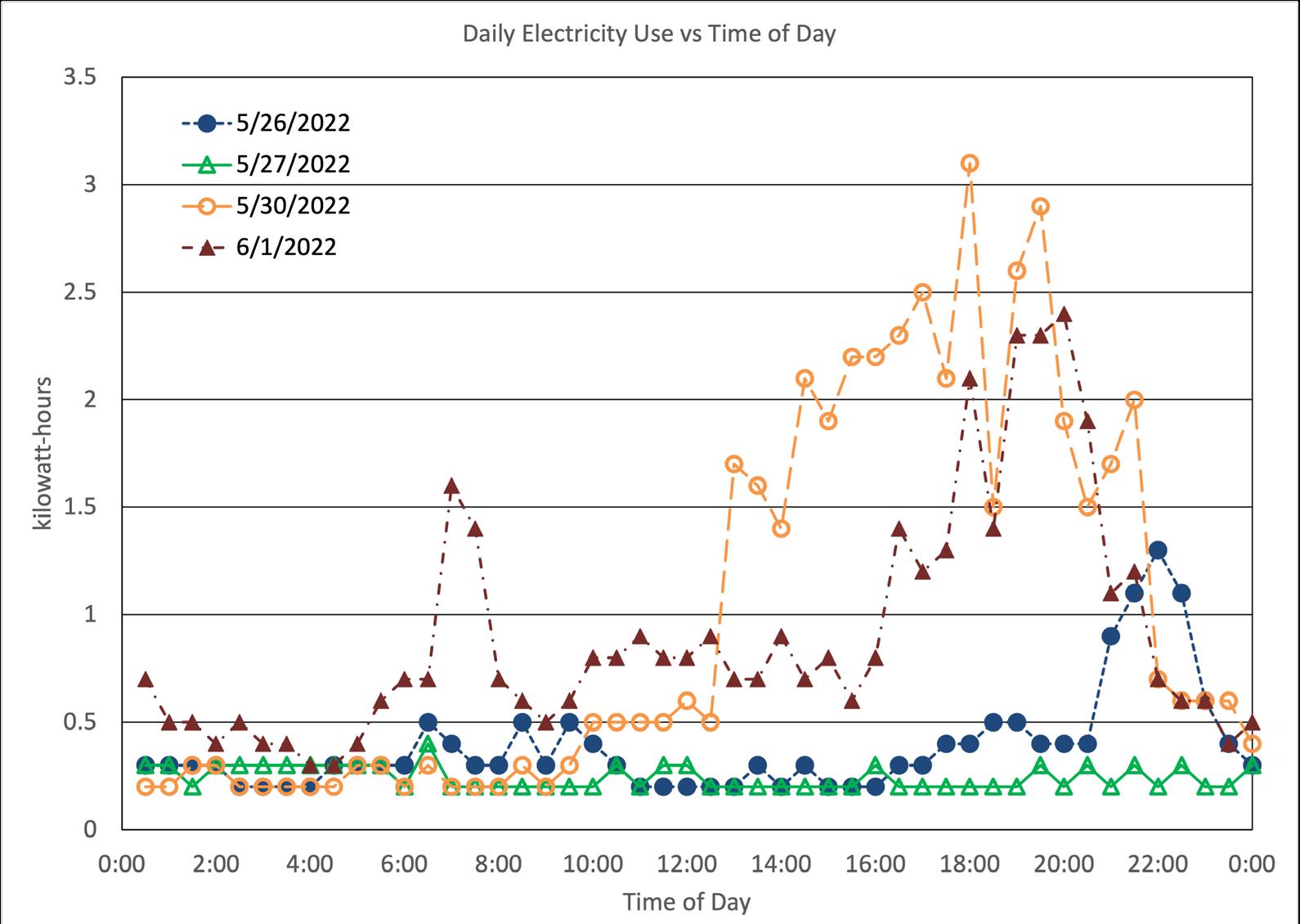
1. What period of the day (morning, midday, evening, nighttime) does the family use the most electricity? How can you tell?
2. On which day did the family use the most total electricity?
3. One of the days, the family was on vacation. Which day do you think it was? What evidence in the graph tells you this?
4. One of the days, the family got home from vacation. Which day do you think it was? What evidence in the graph tells you this?
5. Suppose the family had to pay less for electricity used before noon and more for electricity used after noon. List three pieces of advice you would give this family to help them keep their electricity costs down.
Some utilities charge customers on a tiered system. This encourages customers to keep their total electricity use down. Utilities with customers that have any kind of meter can utilize this system. The table below shows how a tiered system might work.
For example, if a family uses 625 kWh of electricity in a month, they will be charged $45.00 for the first 300 kWh, $36.00 for the next 200 kWh, and $28.75 for the last 125 kWh, for a total of $109.75 for their electricity use. There will be other charges such as connectivity, maintenance, and taxes.
Use the following chart to answer the questions on page 16.

1. This family’s home uses electricity to heat water and the interior of their home. Which day(s) do you think were coldest? Why do you think that?
2. The family’s utility provider charges $0.22 for up to 400 kWh used, $0.26 for 400-700 kWh used, and $0.32 for more than 700 kWh. What was the family’s electricity charge for this month?
3. On which days did the family move up a tier in pricing?
4. What are three things the family could have done to use less electricity?
CONTINUED ON NEXT PAGE
Some utilities charge customers based on a time-of-day use. The purpose of having time-of-day pricing is to keep demand on electricity down during the late afternoon when demand is highest, especially in summer months. A time-of-day rate chart may look something like this:
/
Look at the chart, “Daily Electricity Use vs Time of Day” in the Analyzing Electricity Use activity on page 13. Use it and the time-of-day rate chart above to answer the questions.
1. On which day would the family be charged the most for electricity used during the most expensive time of day?
2. Assuming their electricity use is about the same, what are three things the family could do to make their electricity bill less expensive?
Conclusion
1. Talk to your family to find out if you have a tiered pricing or time-of-day rate plan. Do you have either? Which do you have?
2. What are five things you and your family can do to reduce your overall electricity use?
3. What are three things you and your family could do to keep costs low when being charged according to a time-of-day rate?

The picture above represents what you might find in a typical kitchen with smart devices. Shopping trips are a little easier for this family because they can use a smart phone to see inside the refrigerator, and not forget a needed item. Nobody has to wonder if the dishwasher has clean or dirty dishes, because they can ask the assistive surface device if it was run. If someone falls asleep with a lamp left on, it can be turned off remotely and not disturb the sleeping person. This family can ask the assistant surface device to increase the sound on the TV, dim the lights, start the dishwasher, and unlock the front door. A smart phone connected to all of these devices allows the adults in the family to know who is at the door, whether the garage door is open, and what are the temperatures inside the refrigerator, freezer, and home.
1. Circle the smart devices you see in the picture.
2. List below any other smart devices you think could be in the home that are not visible or obvious in the picture or the paragraph below it.
3. What are three ways smart devices can help this family save energy?
4. What smart devices would you like in your home? Why would you like to have them?
5. If you were an inventor, what smart devices would you create? Explain why you think those devices are needed.
You’ve learned about the grid, or the system of interconnected transmission and distribution lines that carry electricity from power plants and generating sites to homes and businesses. A microgrid is just a very small version of the power grid that can stand on its own power supply with a limited number of buildings connected to it.
Some microgrids are single buildings with many occupants. An example would be a high-rise with apartments or condominiums, office space, and stores or restaurants. Sometimes these buildings have parking structures in the levels below ground. The owner of the building may decide to cover the roof of the building with solar panels and connect the homes and businesses to the solar system, providing some or all of their electricity needs. This would be one microgrid.
Small island communities sometimes have a single power plant or generating source such as a hydropower plant. This power plant provides power to the small community and does not distribute the power to the rest of the grid. Because it is an isolated community with its own isolated power source, it is another type of microgrid.
You will be building DC circuits to “power” one or two buildings on your own microgrid map.
2 Meters of copper tape
2 LEDs
1 Coin battery
Tape or glue
Microgrid worksheet page
Procedure
1. Decide where in the country your microgrid will be built. Your teacher may assign you a location or you may be free to choose.
2. Use the State Electricity Profile from the U.S. Energy Information Administration to decide which energy source makes the most sense for your microgrid. You can reach this source by clicking on this link: https://www.eia.gov/state/.
3. In the box, draw or write the energy source you will use to power your microgrid.
4. The pictures on the page represent grid components and end users of electricity. Connect all the components in order, and connect the power source to the end users, by drawing lines between them.
5. Turn the page over. On the back you will see a pre-drawn pathway for constructing a simple DC circuit with a dark, rectangular line. The small circle indicates where an LED will be placed. It should correspond to one of the houses on the front of the page.
6. Apply copper tape to the pathway of the circuit. Make sure the corners are well connected. Leave a break in the tape at the site of the LED.
7. Use the coin battery and LED to determine the proper orientation of the LED in the circuit by pushing the battery between the two leads on the LED. If the LED lights, it is properly oriented. If not, flip the battery. Note which surface of the battery corresponds to the shorter lead and which corresponds to the longer lead.
8. Bend the LED leads outward so they form a right angle. Poke a hole in the circle where the LED should be placed, and push the LED through the circle so the leads are on top of the copper tape. Note which lead is the short lead.
9. Apply small pieces of copper tape over the LED leads so they are securely and tightly connected to the copper tape. You want to ensure you have a good connection here.
10. Crease the paper in the corner where the dotted line is. Folding this corner over will act as the switch in your circuit.
11. Place your battery so the correct side or terminal (+ or -) is connected to the appropriate lead of the LED.
12. Fold the corner of your paper over and pinch it together. You can use a binder clip to hold it in place. The LED should light. If it does not, unfold, flip the battery and try again. If it still does not light, make sure your copper tape on the battery does not connect the textured negative terminal to the edge of the battery, which is the positive terminal. If it does, you are short-circuiting the battery and current will not flow through the LED. Keep troubleshooting until you get the LED to light. You need the following 3 conditions to be met for the LED to light:
a. A continuous length of copper tape. Any breaks or gaps will not allow current to flow.
b. Good connection between the copper tape and the LED leads.
c. Proper orientation of the battery according to the placement of the LED.
13. To light a second house or building, poke a hole through the lighter circle in the middle of the page. It should align with another house on the front of the page.
14. Apply copper tape to the lines leading to the second circle, leaving a space.
15. Insert a second LED at the circle and secure with small pieces of copper tape. Make sure its orientation matches that of the original LED.
16. Insert the battery and close the switch again. If both LEDs do not light, make sure they are both aligned in the same direction, and make sure you have good connections along all the copper tape junctions.
1. When you constructed your first circuit, you built a simple, series, parallel circuit (circle the correct answer). How do you know this is the type of circuit you built?
2. When you added the second LED, what kind of circuit did you then have on your paper? How do you know?
3. One LED requires 3 volts to light. If you were to add LEDs to every building on the front of your microgrid page, how would you connect them? How many batteries would you need? Explain your answer. Draw a diagram to show how it would work.
4. Why did you choose the power source you wrote or drew on your page? What values did you use to make the decision? What limiting factors kept you from choosing something different? Would you need additional or backup sources for your town? If so, which would you choose and why?
You’ve learned about the grid, or the system of interconnected transmission and distribution lines that carry electricity from power plants and generating sites to homes and businesses. A microgrid is just a very small version of the grid that can stand on its own power supply with a limited number of buildings connected to it.
Some microgrids are single buildings with many occupants. An example would be a high-rise with apartments or condominiums, office space, and stores or restaurants. Sometimes these buildings have parking structures in the levels below ground. The owner of the building may decide to cover the roof of the building with solar panels and connect the homes and businesses to the solar system, providing some or all of their electricity needs. This would be one microgrid.
Small island communities sometimes have a single power plant or generating source such as a hydropower plant. This power plant provides power to the small community and does not distribute the power to the rest of the grid. Because it is an isolated community with its own isolated power source, it is another type of microgrid.
You will be building DC circuits to “power” one or two buildings on your own microgrid map.
2 Meters of copper tape
2 LEDs
1 Coin battery
Tape or glue
Blank sheet of paper
Envelope with grid components
1. Decide where in the country your microgrid will be built. Your teacher may assign you a location or you may be free to choose.
2. Use the State Electricity Profile from the U.S. Energy Information Administration to decide which energy source makes the most sense for your microgrid. You can reach this source by clicking on this link: https://www.eia.gov/state/.
3. Take the small pictures of grid components out of the envelope and spread them out on your desk. Arrange them in order from power plant to end users, with grid components between them, in the right order.
4. In the upper left corner of a blank sheet of paper, write or draw a picture to represent your chosen energy source for your microgrid’s power plant.
5. Tape or glue the pictures on your paper so they are laid out correctly and form a microgrid. Draw lines between them to indicate connections.
6. Turn the page over. Draw a dotted line in the corner where your power plant is situated on the front, so it makes a triangle. This will be where you place your battery. Folding the corner over will act as a switch to close the circuit.
7. Draw a circle underneath one of the houses in your microgrid. You will place an LED in this location.
8. Draw lines to indicate a circuit from the battery, through the LED, and back to the battery.
9. Apply copper tape to the pathway of the circuit. Make sure any corners are well connected. Leave a break in the tape at the site of the LED.
10. Use the coin battery and LED to determine the proper orientation of the LED in the circuit by pushing the battery between the two leads on the LED. If the LED lights, it is properly oriented. If not, flip the battery. Note which surface of the battery corresponds to the shorter lead and which corresponds to the longer lead.
11. Bend the LED leads outward. Poke a hole in the circle where the LED should be placed, and push the LED through the circle so the leads are on top of the copper tape. Note which lead is the short lead.
12. Apply small pieces of copper tape over the LED leads so they are securely and tightly connected to the copper tape. You want to ensure you have a good connection here.
13. Crease the paper in the corner where the dotted line is. Folding this corner over will act as the switch in your circuit.
14. Place your battery so the correct terminal (+ or -) is connected to the appropriate lead of the LED.
15. Fold the corner of your paper over and pinch it together. You can use a binder clip to hold it in place. The LED should light. If it does not, unfold, flip the battery and try again. If it still does not light, make sure your copper tape on the battery does not connect the textured negative terminal to the edge of the battery, which is the positive terminal. If it does, you are short-circuiting the battery and current will not flow through the LED. Keep troubleshooting until you get the LED to light. You need the following 3 conditions to be met for the LED to light:
a. A continuous length of copper tape. Any breaks or gaps will not allow current to flow.
b. Good connection between the copper tape and the LED leads.
c. Proper orientation of the battery according to the placement of the LED.
16. To light a second house or building, draw a circle beneath a second house in your microgrid. Determine how this LED should be connected to the circuit, and draw lines where the copper tape will be applied.
17. Apply copper tape to the lines leading to the second circle, leaving a space.
18. Insert a second LED at the circle and secure with small pieces of copper tape. Make sure its orientation matches that of the original LED.
19. Insert the battery and close the switch again. If both LEDs do not light, make sure they are both aligned in the same direction, and make sure you have good connections among all the copper tape junctions.
The button batteries and mini LED lights used to create this circuit are choking hazards and dangerous if swallowed. Please use caution, and ensure all parts are securely fastened and kept away from children. Seek help immediately if batteries or bulbs are swallowed.
1. When you constructed your first circuit, you built a simple, series, parallel circuit (circle the correct answer). How do you know this is the type of circuit you built?
2. When you added the second LED, what kind of circuit did you then have on your paper? How do you know?
3. One LED requires 3 volts to light. If you were to add LEDs to every building on the front of your microgrid page, How would you connect them? How many batteries would you need? Explain your answer. Draw a diagram to show how it would work.
4. Why did you choose the power source you wrote or drew on your page? What values did you use to make the decision? What limiting factors kept you from choosing something different? Would you need additional or backup sources for your town? If so, which would you choose and why?
Please use caution, and ensure all parts are securely fastened and kept away from children. Seek help immediately if batteries or bulbs are swallowed.
WARNING: The button batteries and mini LED lights used to create this circuit are choking hazards and dangerous if swallowed.
Wouldn’t it be nice if you always knew ahead of time when your home would lose power? You could make sure critical electronics were properly powered down and that your refrigerator and freezer were sufficiently full with bottles or jugs of water to help keep them cold while the power was out. You could even purchase a generator ahead of time before demand was high and supplies ran low.
Unfortunately, no one has a crystal ball to predict when a storm will knock out power. Even the best weather forecasting is not 100% accurate, and storms don’t always behave as predicted. Additionally, not all power disruptions are because of weather, but because of other strains to the power grid. Even if you have supplies and a way of restoring some of your power with an independent, gasoline-powered generator, it will not be able to provide all of the power your home needs and you’ll have to prioritize.
1. Using your utility provider’s online user interface, record your family’s electricity use in the chart on page 27. In the “notes” column, record when you ran large appliances like laundry machines, electric ranges, or dishwashers.
2. What is the average kWh used by your family each day? _____________ kWh
3. What time of day (morning, afternoon, evening, overnight) did your family use the most electricity?
4. Look at the devices and appliances your family uses on a regular basis. Using a meter, the power rating of a light bulb, or the Underwriter Laboratories name plate on a plug-in device, determine the amount of power each uses when running. Some suggestions are listed on page 28, as well as some blank space to add devices your family uses on a regular basis. If something on the list is not used by your family, just leave it blank. The data for electric water heaters has been provided because it may be difficult for you to locate it.
5. Let’s suppose your family loses power for three days. You already own a generator that will run your refrigerator and up to 500 watts of additional power use. Which of your appliances will you allow to be used? Which are things you must do without? Explain your answer and include the data you collected in your explanation.
6. If you had a solar system installed on your home, or a small wind turbine for your home, how would that change your strategy for number 5?
7. Research methods of energy storage. What makes sense for you? Is a battery bank practical? Are there any other means of storing electricity that makes sense for you in your area? If money were no object, what types of energy storage would you incorporate?
8. How would your strategy for number 5 change if you added the storage you described in number 6?
9. Energy conservation describes behavior that uses less energy while still doing things we need to do. For example, we need indoor lighting, but good energy conservation says we don’t turn on more lights than necessary, and we turn them off when we are finished using them. What are some good energy conservation tactics you would employ during your family’s three-day power outage?
1. Spend a full day using as little electricity as possible. Eat cold or uncooked meals, play outside, use daylight from windows to read, etc. Describe what you did and how it was different from days where you don’t think about the electricity you use.
2. How are smart meters and a smart grid system helpful in preparing for a loss of power?
3. What will you do the next time your home loses power? Be specific in your description.
Source: https://www.electricalclassroom.com/power-energy-use-of-water-heater/
Source: https://hvacseer.com/how-often-does-water-heater-run/
The United States uses a lot of energy. With about 4.4 percent of the world’s population, we consume about 17 percent of the world’s energy resources. All of us use energy every day—for getting from one place to another, cooking, heating and cooling rooms, making products, lighting, heating water, using and charging electronics, and entertainment. We use a lot of energy to make our lives comfortable, productive, and enjoyable. Most of that energy is from nonrenewable energy sources. It is important that we use our energy resources wisely.
Energy is found in different forms, such as light, heat, sound, and motion, and energy is always changing forms. There are many forms of energy, but they can all be put into one of two categories: potential and kinetic.
POTENTIAL ENERGY
Potential energy is stored energy and the energy of position, or gravitational potential energy. There are several forms of potential energy.
Chemical Energy is energy stored in the bonds of molecules. It is the energy that holds these particles together. Biomass, petroleum, natural gas, and propane are examples of stored chemical energy.
Elastic Energy is energy stored in objects by the application of a force. Compressed springs and stretched rubber bands are examples of elastic energy.
Nuclear Energy is energy stored in the nucleus of an atom; it is the energy that holds the nucleus together. The energy can be released when the nuclei are combined or split apart. Nuclear power plants split the nuclei of uranium atoms in a process called fission. The sun combines the nuclei of small atoms, mostly hydrogen, in a process called fusion.
Gravitational Potential Energy is the energy of position or place. A rock resting at the top of a hill contains gravitational potential energy. Hydropower, such as water in a reservoir behind a dam, is an example of gravitational potential energy.
KINETIC ENERGY
Kinetic energy is the energy of motion; it is the motion of waves, electrons, atoms, molecules, substances, and objects.
Electrical Energy is the movement of electrons. Everything is made of tiny particles called atoms. Atoms are made of even smaller particles called electrons, protons, and neutrons. Electrons are always moving. Applying a force can make some of the electrons move faster or in a desired direction. Electrons moving through a wire are called electricity. Lightning is another example of electrical energy.
Radiant Energy is electromagnetic energy that travels in transverse waves. Radiant energy includes visible light, x-rays, gamma rays, and radio waves. Light is one type of radiant energy. Solar energy is an example of radiant energy.
Thermal Energy, or heat, is the internal energy in substances; it is the vibration and movement of the atoms and molecules within substances. The more thermal energy in a substance, the faster the atoms and molecules vibrate and move. Geothermal energy is an example of thermal energy.
Motion Energy is the movement of objects and substances from one place to another. Objects and substances move when a force is applied according to Newton’s Laws of Motion. Wind is an example of motion energy.
Sound Energy is the movement of energy through substances in longitudinal (compression/rarefaction) waves. Sound is produced when a force causes an object or substance to vibrate; the energy is transferred through the substance in a longitudinal wave.
The Law of Conservation of Energy is not about saving energy. The law states that energy is neither created nor destroyed. When we use energy, it does not disappear; it changes from one form into another. A car engine, for example, burns gasoline, converting the chemical energy in the gasoline into useful motion; some of the energy is also converted into light, sound, and heat. Solar cells convert radiant energy into electrical energy. Energy changes form, but the total amount of energy in the universe remains the same.
We use many different sources to meet our energy needs, all of which have advantages and disadvantages. Some are relatively cheap; others are expensive. Some can emit pollutants and contribute to global climate change, while others do not emit greenhouse gases or pollutants. Some are limited in their supplies; others are abundant. Some are always available; others are available only part of the time.
Energy sources are classified into one of two groups—renewable and nonrenewable. In the United States, most of our energy comes from nonrenewable energy sources. Coal, natural gas, petroleum, propane, and uranium are nonrenewable energy sources. They are used to make electricity, heat buildings, move vehicles, and manufacture all kinds of products. These sources are called nonrenewable because the reserves of the fuels are limited. Petroleum, for example, was formed hundreds of millions of years ago from the remains of ancient sea plants and animals. We cannot make more petroleum in a short time or as quickly as we consume it. Renewable energy sources include biomass, geothermal energy, hydropower, solar energy, and wind energy. They are called renewable because they are replenished by nature in a short time. Day after day, the sun shines, the wind blows, the rivers flow, and plants grow. Heat from inside the Earth—geothermal energy—is continuously made by the radioactive decay of elements in the Earth’s core. We can harness this renewable energy to do work for us. We use renewable energy sources mainly to make electricity. Is electricity a renewable or nonrenewable source of energy? The answer is neither. Electricity is different from the other sources because it is a secondary source of energy. That means we have to use another source of energy to make it. In the United States, natural gas is the number one fuel for generating electricity. See page 32 for more information on sources for electricity generation.
The choices we make about using energy have environmental and economic impacts. There are many things we can do to use less energy and use it wisely. These actions include both energy conservation and energy efficiency.
Energy Conservation
Energy conservation is any action that results in using less energy. Energy efficiency focuses on technologies that use less energy to perform the same tasks. Buying a dryer that uses less energy is an example of energy efficiency. Drying clothes outside on sunny days is an example of energy conservation.
Energy Efficiency
Energy efficiency is the amount of useful energy produced by a system compared to the energy input. A perfect energy-efficient machine would convert all of the input energy into useful work. This “perfect machine” currently does not exist. Converting one form of energy into another form always involves a loss of usable energy. This is called a conversion loss and is usually in the form of heat. This “waste heat” spreads out quickly into the surrounding environment and is very difficult to contain or trap.
*Propane consumption is included in petroleum and natural gas gures.
Data: Energy Information Administration **Total does not equal 100% due to independent rounding.
A typical power plant that is fueled by thermal energy transformations like coal, natural gas, or uranium, converts about 35 percent of the energy in the fuel into electricity. The rest of the energy is lost as heat. A hydropower plant, on the other hand, converts about 95 percent of the energy in the water flowing through the system into electricity.
Most energy transformations are not very efficient. The human body is a good example. Your body is like a machine, and the fuel for your machine is food. The typical body is less than five percent efficient at converting food into useful work such as moving, thinking, and controlling body processes. The rest is converted to heat. The efficiency of a typical gasoline powered car is about 15 percent.
Efficiency and conservation are key components of energy sustainability—the concept that every generation should meet its energy needs without compromising the needs of future generations. Sustainability focuses on long-term actions that make sure there is enough energy to meet today’s needs as well as tomorrow’s.
Sustainability also includes the development of new clean technologies for using fossil fuels, promoting the use of renewable energy sources, and encouraging policies that protect the environment.
The U.S. Department of Energy classifies energy users into categories: residential, commercial, industrial, electric power generation, and transportation. These categories are called the sectors of the economy.
Residences are people’s homes. Commercial buildings include office buildings, hospitals, stores, restaurants, and schools. Residential and commercial energy use are often lumped together because homes and businesses use energy in the same ways—for heating, air conditioning, water heating, lighting, and operating appliances.
The graphic to the right shows that the electric power generation sector consumed the most primary energy in 2021. However, all of the other sectors, especially the residential, commercial, and industrial sectors, use electricity after it is generated. The other sectors are the end users of electric power. When the residential and commercial sectors of the economy are combined together and electricity consumption is included, the residential and commercial sectors consume more energy than any of the other sectors. These two sectors actually account for nearly 39 percent of the total energy consumed by the U.S., when electricity is included.
Most thermal power plants are about 35 percent e cient. Of the 100 units of energy that go into a plant, 65 units are lost as one form of energy is converted to other forms. The remaining 35 units of energy leave the plant to do usable work.




How a Thermal Power Plant
1. Fuel is fed into a boiler, where it is burned (except for uranium, which is ssioned) to release thermal energy.
2. Water is piped into the boiler and heated, turning it into steam.
3. The steam travels at high pressure through a steam line.
4. The high pressure steam turns a turbine, which spins a shaft.
5. Inside the generator, the shaft spins a ring of magnets inside coils of copper wire. This creates an electric eld, producing electricity.
6. Electricity is sent to a switchyard, where a transformer increases the voltage, allowing it to travel through the electric grid.

does not equal
due to independent rounding.
Electricity is the flow of electric power or charge. Electricity is naturally occurring in nature, but we also generate a lot of electricity to meet our everyday needs.
Power plants use huge turbine generators to generate the electricity we use in our homes and businesses. Power plants use many fuels to spin the turbines. They can burn coal, oil, or natural gas to make steam to spin turbines. They can split atoms of uranium to heat water into steam. They can also use the power of rushing water from a dam or the wind to spin the turbine.
A generator is an engine that converts motion energy into electrical energy using electromagnetism. A turbine is a device that converts the flow of air, steam, or water into motion energy to power a generator.
Power plants use huge turbine generators to make the electricity we use in our homes and businesses. The turbine is attached to a shaft in the generator. Inside the generator are magnets and coils of copper wire. The generator can be designed in two ways: the turbine can spin coils of wire inside magnets or can spin magnets inside coils of wire. In either design, the electrons are pushed very quickly from one copper atom to another inside the wire by the moving magnetic field created as the magnets and wire spin around each other.
The electrons in the copper wire then flow into transmission lines. These moving electrons are the electricity that flows to our houses.








Four basic types of power plants generate most of the electricity in the United States—fossil fuel, nuclear, wind, and hydropower. There are also geothermal, waste-to-energy, and solar power plants, but they generate less than ten percent of the electricity produced in the United States.
Fossil Fuel Power Plants: Fossil fuel plants burn coal, natural gas, or oil. These plants use the chemical energy in fossil fuels to superheat water into steam, which drives a turbine generator. Fossil fuel plants are sometimes called thermal power plants because they use heat to generate electricity. Natural gas is the fossil fuel of choice for most electric companies, producing 38.3 percent of total U.S. electricity. Coal plants produce 21.8 percent. Petroleum produces less than one percent of the electricity in the U.S.
Nuclear Power Plants: Nuclear plants generate electricity similarly to fossil fuel plants except that the furnace is called a reactor, the fuel is uranium, and no fuel is burned. In a nuclear plant, a reactor splits uranium atoms into smaller elements, producing heat in the process. The heat is used to superheat water into high-pressure steam, which drives a turbine generator. Nuclear power plants are called thermal plants because they use heat to generate electricity. Nuclear energy produces 18.9 percent of the electricity in the U.S.
Wind: Wind farms are installations of dozens or even hundreds of largescale wind turbines. Each turbine on land can generate about 2.5 MW of power, and offshore turbines can generate up to 15 MW. Since 1995 wind generation has been the fastest-growing renewable source of electricity. The energy in wind is captured by the blades of the turbine, spinning it. The turbine is connected to a generator through a gear box that ensures the generator spins at the correct speed. While electricity generated by wind was at first very expensive, it is now one of the most cost-effective ways to generate electricity. Wind farms account for 9.2 percent of electricity generation in the U.S.
Hydropower Plants: Hydropower plants use the gravitational force of falling water to generate electricity. Hydropower is the least expensive way to produce electricity in this country, but there are few places where new dams can be built. There are some existing dams that could be retrofitted with turbines and generators. Hydropower is called a renewable energy source because it is renewed continuously during the natural water cycle. Hydropower produces five to ten percent of the electricity in the U.S., depending upon the amount of precipitation.


Other thermal power plants: Waste-to-energy, solar thermal, and geothermal power plants can also be used to generate electricity. These facilities make up a small portion of U.S. electricity generation. However, they operate very similarly to fossil fuel-powered facilities. Waste-to-energy facilities burn garbage, landfill gas, or other waste to create steam to drive a turbine generator. Geothermal power plants use existing high-temperature steam from within the Earth to drive the turbine generator. Solar thermal or Concentrated Solar Power (CSP) facilities focus the sun’s light onto a surface and use it to heat liquids to create steam and drive the generator.
Electricity can also be produced in other ways. A solar cell in a solar panel turns radiant energy into electricity using the photo electric effect and semiconductors. A battery turns chemical energy into electricity.
A battery produces electricity using two different metals in a chemical solution. A chemical reaction between the metals and the chemicals frees more electrons in one metal than in the other. One end of the battery is attached to one of the metals; the other end is attached to the other metal. The end that frees electrons develops a positive charge and the other end develops a negative charge. If a wire is attached from one end of the battery to the other, electrons flow through the wire to balance the electrical charge.
A load is a device that does work or performs a job. If a load—such as a light bulb—is placed along the wire, the electricity can do work as it flows through the wire. In the picture to the right, electrons flow from the end of the battery, through the wire to the light bulb. The electricity flows through the wire in the light bulb and back to the battery.
Electricity travels in closed loops, or circuits. It must have a complete path before the electrons can move. If a circuit is open, the electrons cannot flow. When we flip on a light switch, we close a circuit. The electricity flows from the electric wire through the light and back into the wire. When we flip the switch off, we open the circuit. No electricity flows to the light. If the bulb burns out, the path through the bulb is gone, and the circuit is also opened. When we turn on the TV, electricity flows through wires and bulbs inside the set, producing pictures and sound. Sometimes electricity runs motors in items such as washers or mixers. Electricity does a lot of work for us. We use it many times each day.
Most electricity is generated by large utility companies; it is their responsibility to make sure electricity is available when we need it. They must consider reliability, capacity, baseload, power pools, and peak demand.
Reliability is the capability of a utility company to provide electricity to its customers 100 percent of the time. A reliable electric service is without blackouts or brownouts. To ensure uninterrupted service, laws require most utility companies to have 15 to 20 percent more capacity than they need to meet peak demand.
This means a utility company whose peak load is 12,000 MW (megawatt) must have 14,000 MW of installed electrical capacity. This ensures that there will be enough electricity to meet demand even if equipment were to break down on a hot summer afternoon.
Capacity is the total quantity of electricity a utility company has online and ready to deliver when people need it. A large utility company may operate several power plants to generate electricity for its customers. A utility company that has seven 1,000-MW plants, eight 500-MW plants, and 30 100-MW plants has a total capacity of 14,000 MW.
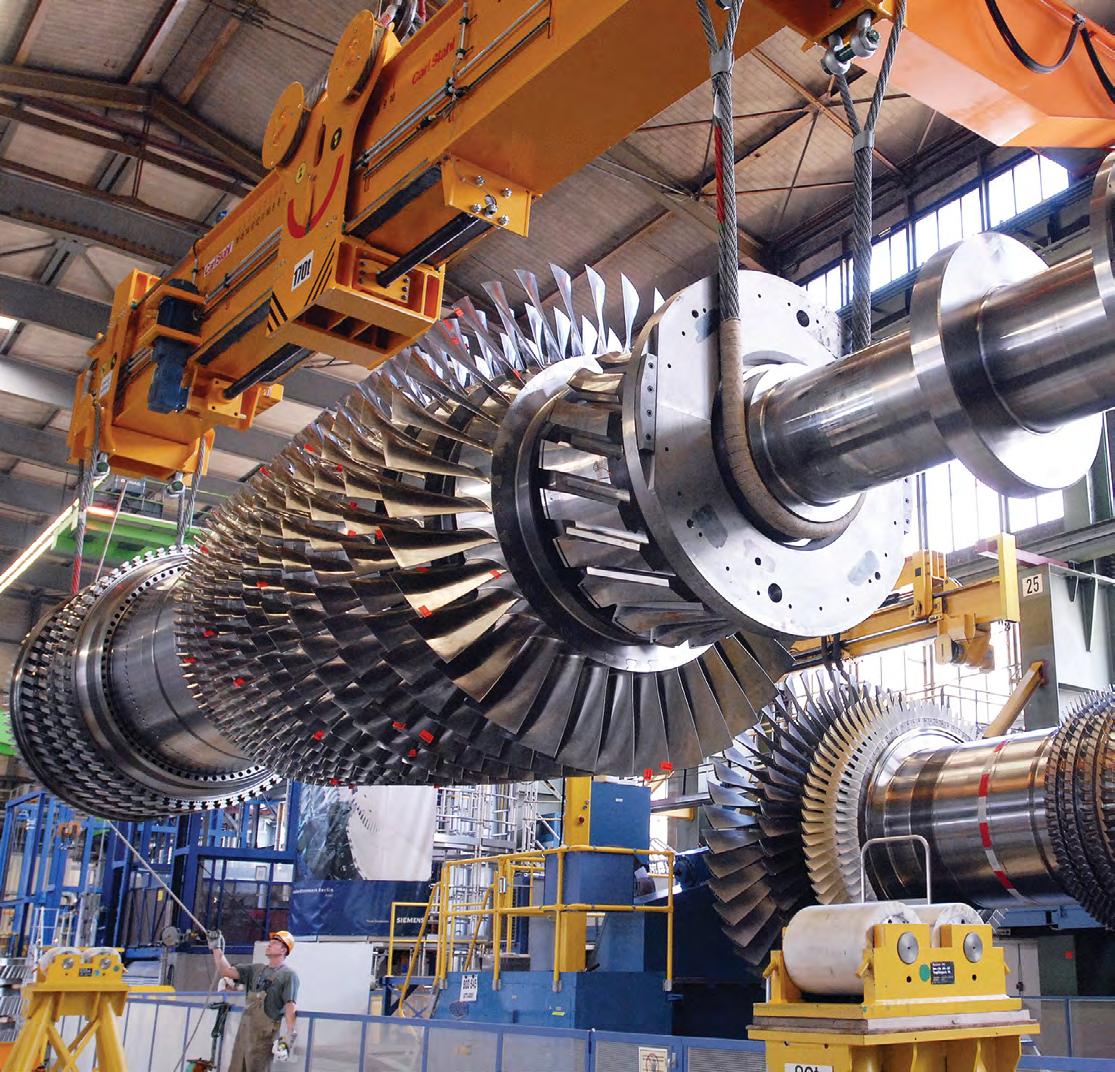
Baseload power is the electricity generated by utility companies around the clock, using the most inexpensive energy sources— usually coal, nuclear, and hydropower. Baseload power stations usually run at full or near capacity.
When many people want electricity at the same time, there is a peak demand. Power companies must plan for times of peak demand so there is enough power for everyone. During the day’s peak, between
12:00 noon and 6:00 p.m., additional generators must be used to meet a higher demand for energy use. These peak load generators run on natural gas, diesel, or hydro and can be put into operation in minutes. The more this equipment is used, the higher our utility bills. By managing the use of electricity during peak hours, we can help keep costs down.
The use of power pools is another way that electric power companies make their systems more reliable. Power pools link electric utilities together so they can share power as it is needed. A power failure in one system can be covered by a neighboring power company until the problem is corrected. There are nine regional power pool networks in North America. The key is to share power rather than lose it.

To deliver electricity to consumers, there are more than 160,000 miles of high-voltage electric transmission lines across the U.S. These lines move the electricity produced at power plants to transformers that step up the voltage to reduce energy loss while the electricity travels along the grid to where it is going to be used. Before coming into your home, another transformer steps down the power to 120 volts so it can operate your lights, appliances, and other electrical needs. And most remarkably of all, this entire process—from generation at the power plant to the trip along the lines to its availability for use in your home—takes just a fraction of a second!
These transmission lines, whether they are located on poles above ground or buried underground, make up the most visible part of what is called the “electric grid.” The grid consists of the power generators, the power lines that transmit electricity to your home, the needed components that make it all work, and the other homes and businesses in your community that use electricity.
The process starts at the power plant that serves your community and ends with wires running from the lines into your home. Outside your home is a meter with a digital readout or a series of dials that measure the flow of energy to determine how much electricity you’re using. Of course, there are many more parts to this process, ranging from substations and wires for different phases of current to safety devices and redundant lines along the grid to ensure that power is available at all times. You can see why the U.S. National Academy of Engineering has called America’s electric grid “the greatest engineering achievement of the 20th century.”
Peak load is the maximum load during a speci ed period of time.
The transmission grid, also known as the electric grid, or simply “the grid,” connects electric power generators to the end users of electricity —the customers of electric utilities. Between the outlet in your wall and the power plant where the electricity is generated is a network of transformers, substations, transmission lines, and distribution lines, and regulatory agencies making sure it’s all functioning correctly and that you are getting the power that you need.
Ideally, the grid would have been designed and developed with an overall plan in mind. However, it has been built, added on to, and expanded as populations have increased and people have moved from cities to more suburban and rural living. If the map of the electric grid looks haphazard, that’s because it was built on an as-needed basis. As you can imagine, something this old, without an overarching plan for construction and expansion, has its drawbacks and vulnerabilities.
The first problem with the grid system today is that it is old. The towers are old, the wires are old, and the whole thing sits exposed to weather. As severe weather events like tornadoes and tropical storms increase in frequency and severity, problems with the grid system also increase. In 2013, the average US electricity customer experienced 3.5 hours without power. In 2020, that average increased to about 8 hours. Electricity is necessary to keep us safe and healthy. Any amount of time without power has the potential to cause food spoilage, and extended amounts of time without power can cause injury or death due to extremely high or low temperatures. In short, any service interruption is at least inconvenient and could be deadly.
Electric utilities and independent system operators (ISOs) have been working toward updating and modernizing the grid system. Currently, when demand is exceptionally high, the grid system fails, causing blackouts. Demand is exceptionally high during extremely high or low temperatures, when people are running their air conditioning or heating systems much more than usual. Modernizing the grid will prevent this from happening or at the very least reduce its frequency.
What does a modern grid look like? It includes the current system of lines and towers, but adds things like sensors, controls, and twoway communication networks that allow for the ISO to know when a problem occurs and send a signal to help correct it. This is called real-time monitoring, and it provides an avenue for power providers to anticipate and intercept a problem before it affects end users.
The U.S. Energy Information Administration, or EIA, has a website where you can see how power demand and generation have been changing throughout the day. It’s called the Hourly Electric Grid Monitor, and can be accessed by navigating to https://www.eia.gov/electricity/ gridmonitor/dashboard/electric_overview/US48/US48
Homes and apartment buildings are equipped with meters so that utilities can determine how much electricity and natural gas each residence consumes. Some homes, apartment buildings, and commercial buildings in the U.S. may still have analog electric meters. These meters contain an aluminum disk. As electricity enters the house, it passes through a pair of loops that creates a magnetic field. This creates an eddy current in the disk and causes the disk to rotate. The speed the disk rotates is proportional to the amount of power being consumed. As the disk spins, hands on dials move to record how much electricity has been consumed.
In the 1980s, digital meters began to appear on homes, apartment buildings, and commercial buildings. These meters measure current
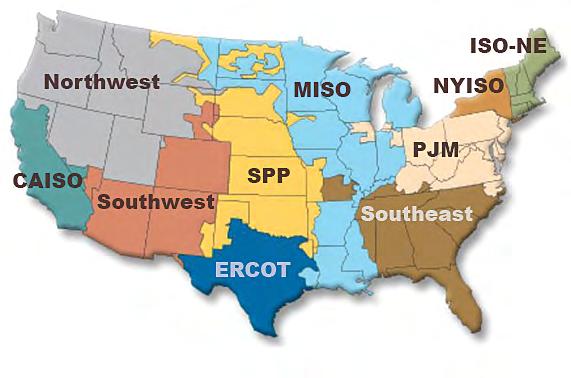
CAISO/California
Northwest/Northwestern Region
Southwest/Southwestern Region
SPP/Southwest Power Pool
ERCOT/Texas (Electric Reliability Council)
MISO/Midcontinent (Midwest and South)
PJM/Mid Atlantic
Southeast/Southeastern region
NYISO/New York
ISO-NE/New England
Map courtesy of Federal Energy Regulatory Commission (FERC)
and voltage digitally to calculate use. Traditionally, both analog and digital meters are read by a meter reader once a month by the utility company and the customer is charged for their electricity use.
You may be thinking that there is little you can do to help the grid modernization situation, but that is not the case. A typical family uses about 900 kWh of electricity in one month. The biggest electricity users in the home are air conditioning, electric water heating where applicable, and refrigeration. By reducing energy use in the home, you can help the power producers manage electricity demand.
Data: U.S. Energy Information Administration
A major goal for utilities and ISOs is to avoid power disruptions like blackouts and brownouts. Weather and accidents are some of the major causes of power disruptions, and they can be tough to plan around and contend with once they occur, as conditions must be safe to make repairs and deliver power back to the people. In many scenarios, power disruptions are an inconvenience for most that will last a few to several hours. However, in some rarer occasions, such as heavily damaging storms or large accidents, power disruptions can last for days, even weeks. One temporary solution for these types of power disruptions is to create access to backup generation through “portable” backup generators. These devices range greatly in size from that of a medium-sized cooler to a shipping container. Facilities like hospitals, shelters, fire houses, police stations, and even schools may have backup generators on-site for emergencies. Others can be rented and trucked in, should an emergency arise. These backup generators are often gas or diesel powered and can operate basic necessities or an entire building. Fun fact: NEED once held a conference at a hotel where an underground transformer blew the power to a threeblock radius. The hotel and other buildings nearby were powered by large, trailer-sized generators until power could be restored several days later.

Another option for major power disruptions is electricity storage, most commonly in the form of batteries. Battery storage works just as you might think - a battery bank is charged up when electricity is plentiful and cheap, and stored for use as needed. Battery storage can be used on a smaller scale like that of a recreational vehicle (RV) or boat. However, large scale battery storage can power basic necessities or entire buildings for several hours before full discharge, depending on the size. This is incredibly helpful when fuel supplies are limited, and emissions and sound pollution from a generator may be too much for a small space. Many of these battery banks are made of lithiumion battery technology, much like the battery found in most cellular phones. To maximize the resiliency of the backup battery device, many opt to incorporate a renewable technology like wind or solar into the system. The renewable energy source allows for the battery to be recharged without any fueling. When renewables are not available to recharge the battery and power is still disrupted, a generator can be connected to the battery bank to recharge it, if ultimately necessary.
The first big step you can take is to take charge of the heating and cooling system in your home. The US Department of Energy recommends setting the thermostat at 68°F in cold weather, and even lower when sleeping or away from home. In hot weather when the air conditioner is in use, set the thermostat at 78°F. Furthermore, make sure windows and doors are tightly sealed when these systems are turned on to avoid air infiltration from outside. A programmable thermostat can help you set the temperatures according to your family’s schedule and help you save energy without having to think about it too much.
If you have an electric water heater, it’s the second-largest user of electricity in your home. Even if you have a natural gas-powered water heater, it’s a good idea to use as little hot water as you can because burning natural gas produces carbon dioxide, which is the primary greenhouse gas responsible for climate change. You can reduce your hot water use in the following ways:
Take showers rather than baths
Fill a sink with water to wash dishes rather than letting the water run
Wash clothes in cool or cold water
Run the dishwasher and washing machine only when they are full
Refrigerators are the third-largest home electricity user, and combined with other appliances like electric ranges, dishwashers, and laundry machines, they account for about 60 percent of the electricity used in the home. Purchasing efficient appliances with the ENERGY STAR® rating ensures that you are buying the appliance that uses the least amount of electricity while still doing its job. How you use the appliance is just as important as how efficient it is, though, so make sure you are not leaving the refrigerator door open or running these appliances unnecessarily. Turning off the heating drying option on your dishwasher will help, too.
Finally, when it comes to electricity use, stick to one rule: If you’re not using it, turn it off. When you’re finished in the bathroom, turn off the light. When you’re done watching TV or playing your video game, turn them off. If you are called away from your video game for more than a few minutes, save and turn it off; don’t just pause the game. If you need white noise to fall asleep, consider using an app on your phone rather than having the TV or a fan on all night long. If those don’t work, use a timer that turns those devices off after you’re asleep. If you can, use a smaller device such as a toaster oven or microwave rather than heating up the large oven.
Data: EIA 2020 RECS *Total
With once-a-month meter readings, it is difficult for consumers to monitor their electricity use. Consumers can adjust their electricity use after they receive their bills, but it’s too late to change their behaviors to affect their current bill. Monitoring electricity use once a month doesn’t help the utilities either. Once electricity is generated in most cases, it has to be used, or else it is lost without storage. In order to better gauge how much electricity is needed at a given time, engineers have designed communication devices that enable energy use information to be sent to utilities more frequently. This technology allows utilities to generate enough electricity to meet their customers’ needs. It also allows utilities to more effectively employ renewable energy resources. These meters are called smart meters.
Smart meters are digital meters similar to those that have been in use for some time. What makes these meters “smart” is the addition of a communication system between the meter and the utility. Most smart meters in the U.S. have wireless two-way communication. However, some utilities are using wired communication. Whether using wired or wireless communication, smart meters work the same way. Rather than sending a meter reader to read meters once a month, the smart meter sends data to the utility on a more frequent basis, at least once a day, throughout the month.
Consumers also can log on to secure websites to monitor their energy use on an hourly basis (even for the previous day). Seeing near real-time data allows the consumers to make changes to their energy use, which will have a direct impact on their energy bill. Many utilities implementing smart meters offer services that will email, call, or text consumers when their electricity use is nearing a higher price bracket, allowing consumers to adjust their electricity use accordingly and avoid higher bills.
Smart meters allow customers to more closely monitor their energy use and, if they choose, make changes in their behaviors to conserve energy.
Wireless Communication
The world around us is filled with tools, devices, and gadgets that many people use as part of modern daily life. Many of these products, such as cell phones, garage door openers, wireless laptops, radios, televisions, microwave ovens, and baby monitors, use radiofrequency or “RF” energy to communicate wirelessly.
In the United States, the Federal Communications Commission (FCC), with input from the Food and Drug Administration (FDA), Environmental Protection Agency (EPA), and other Federal Government agencies, has set limits for the amount of RF energy that products can safely use. The RF communications from smart meters fall well below those limits.
1. Smart meters transmit data to a network relay, often mounted on an electric pole.
2. The relay sends the data to the utility.
3. The utility monitors your electricity consumption.
4. The utility communicates your electric consumption back to you. Special alerts can be sent to emails and mobile phones when electricity usage is pushing you into a higher-priced electric tier.
5. Customers can go online at any time to view their energy usage and costs. Customers can compare their daily consumption to previous days, weeks, months, even years.
6. Customers can make energy-saving changes to their behavior to lower their electricity consumption and their electric bills.
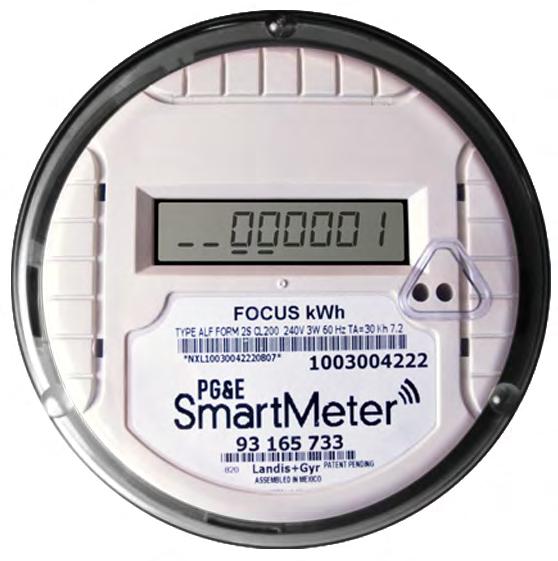
Smart meters communicate to the electric company daily so electricity use can be monitored by consumers more closely. Image courtesy of PG&E
First it was the smart phone, which wasn’t so much smart as multifunctional. Smart phones combine a camera, internet search, email, and phone in one device. People who had once carried a blackberry device, pager, cellphone, and digital camera now could empty their pockets, carry one device, and not lose any functionality. Smart phones have become our portal into the world beyond our reach.
Smart meters are just a small part of what is known as the Internet of Things, or IoT. The IoT is the collection of Wi-Fi-enabled devices that allow users to monitor them remotely and that in turn learn the habits of the user. Some predict what their users will want to do and make the adjustments before the user thinks of it. Smart meters don’t do this, but they do allow electric companies to see increased demand in real-time and make quick adjustments to generation to meet that demand. They also allow utilities to immediately see and start working on eliminating power outages. Many people with smart meters find out their utility companies already know about their power outage before they even report it. This is especially useful when people are not at home.
Smart thermostats allow us to program different settings on our heat or air conditioning according to activities occurring within our homes. If it’s a work day and everyone is away at work or school, the heat can be turned down significantly or the air conditioner set to a higher temperature. Programmable thermostats without the “smart” feature were already allowing us to do this, but smart thermostats have the added benefit of allowing us to change the temperature inside our homes remotely. If for some reason you are released from school or work early, an adult can adjust the temperature on a smart thermostat for you before you get home.
Smart thermostats also “learn” our habits and often change temperatures preemptively for the users. Furthermore, during times of peak demand such as during an intense heat wave, smart thermostats can be controlled by the utility company to pre-cool a house in the morning, allowing the air conditioner to run less often in the afternoon when demand is high.
Appliances can be Wi-Fi-enabled, allowing us to make sure they’re on or off, allowing us to check the temperature in the refrigerator or freezer, even allowing us to see inside the refrigerator from the grocery store! While this seems more like a convenience than an energy-saving feature, eliminating repeat trips to the store saves on energy used for transportation.
Smart devices can add security, too. Garage door openers, doorbell camera systems, security cameras, and even door locks all have smart versions. By being able to use a phone to check to make sure the garage door is closed or to see who is at the front door, a resident can make sure home is safe and secure. Smart locks allow users to remotely open the door; if a family member is accidentally locked out, they can get back inside.
Smart plugs and surge protectors allow users to remotely power off devices. Some surge protectors allow some devices to be always on, while a main device, such as a TV, will determine whether other devices receive power. This is useful for entertainment systems that include a television, Blu-ray player, cable TV device or streaming device, game system, etc. If the TV is not on, the other devices do not need power, either.


There are even light bulbs with Wi-Fi capability that allow users to brighten or dim the lighting in a room, turn lights on or off, or change the color of the light. These lighting systems can be controlled with an app on a smart phone, or with an assistant surface device.
By now you’re wondering how something like an Amazon Echo or Google Home device fit into all of this. These devices, classified as assistant surface devices, allow users to voice-activate things like a TV, lights, lock, or streaming service. They also allow users to make lists or to automatically purchase needed items. One device can coordinate all of the smart devices discussed above much in the same way a smartphone does, without having to pick up the phone.
The IoT also allows companies to create a big picture data set about how people are living their lives at home. While this information allows corporations to cater their goods and services to what people want or need, it also provides opportunities for utilities and power-generating companies to understand how their customers are using energy and to anticipate future needs. Some of the devices within the IoT are convenience-driven while others, like thermostats and lighting, are designed primarily for energy management. As more Wi-Fi-enabled devices are brought to market, greater convenience, time saving, and energy efficiency will be possible.
1. Did you conduct the entire unit?
2. Were the instructions clear and easy to follow?
3. Did the activities meet your academic objectives?
4. Were the activities age appropriate?
5. Were the allotted times sufficient to conduct the activities?
6. Were the activities easy to use?
7. Was the preparation required acceptable for the activities?
8. Were the students interested and motivated?
9. Was the energy knowledge content age appropriate?
10. Would you teach this unit again?
Yes
Yes
Yes
Yes
Yes
Yes
Yes
Yes
Yes
Yes
No
No
No
No
No
No
No
No
No
No Please explain any ‘no’ statement below
How would you rate the unit overall?
How would your students rate the unit overall?
What would make the unit more useful to you?
Other Comments: Please
AES
AES Clean Energy Development
American Electric Power Foundation
Appalachian Voices
Arizona Sustainability Alliance
Atlantic City Electric
Avangrid
Baltimore Gas & Electric
Berkshire Gas - Avangrid
BP America Inc.
Bob Moran Charitable Giving Fund
Cape Light Compact–Massachusetts
Celanese Foundation
Central Alabama Electric Cooperative
CITGO
The City of Cuyahoga Falls
Clean Virginia
CLEAResult
ComEd
Con uence
ConocoPhillips
Constellation
Delmarva Power
Department of Education and Early Childhood
Development - Government of New Brunswick, Canada
Dominion Energy, Inc.
Dominion Energy Charitable Foundation
DonorsChoose
East Baton Rouge Parish Schools
East Kentucky Power Cooperative
EcoCentricNow
EDP Renewables
EduCon Educational Consulting
Elmo Foundation
Enel Green Power North America
EnergizeCT
ENGIE
Entergy
Equinix
Eversource
Exelon
Exelon Foundation
Foundation for Environmental Education
FPL
Generac
Georgia Power
Gerald Harrington, Geologist
Government of Thailand–Energy Ministry
Greater New Orleans STEM
GREEN Charter Schools
Green Power EMC
Guilford County Schools–North Carolina
Honeywell
Iowa Governor’s STEM Advisory Council -
Scale Up
Iowa Lakes Community College
Iowa State University
Illinois Clean Energy Community Foundation
Illinois International Brotherhood of Electrical
Workers Renewable Energy Fund
Independent Petroleum Association of New Mexico
Intuit
Iron Mountain Data Centers
Kansas Corporation Energy Commission
Kansas Energy Program – K-State Engineering
Extension
Katy Independent School District
Kentucky Environmental Education Council
Kentucky O ce of Energy Policy
Kentucky Power–An AEP Company
Liberty Utilities
Llano Land and Exploration
Louisiana State Energy O ce
Louisiana State University – Agricultural Center
LUMA
Marshall University
Mass Save
Mercedes Benz USA
Minneapolis Public Schools
Mississippi Development Authority–Energy Division
Motus Experiential
National Fuel
National Grid
National Hydropower Association
National Ocean Industries Association
National Renewable Energy Laboratory
NC Green Power
Nebraskans for Solar
NextEra Energy Resources
Nicor Gas
NCi – Northeast Construction
North Shore Gas
O shore Technology Conference
Ohio Energy Project
Oklahoma Gas and Electric Energy Corporation
Omaha Public Power District
Ormat
Paci c Gas and Electric Company
PECO
Peoples Gas
Pepco
Performance Services, Inc.
Permian Basin Petroleum Museum
Phillips 66
PowerSouth Energy Cooperative
PPG
Prince George’s County O ce of Human Resource Management (MD)
Prince George’s County O ce of Sustainable Energy (MD)
Providence Public Schools
Public Service of Oklahoma - AEP
Quarto Publishing Group
The Rapha Foundation
Renewable Energy Alaska Project
Rhoades Energy
Rhode Island O ce of Energy Resources
Salal Foundation/Salal Credit Union
Salt River Project
Salt River Rural Electric Cooperative
Schneider Electric
C.T. Seaver Trust
Secure Solar Futures, LLC
Shell USA, Inc.
SMUD
Society of Petroleum Engineers
South Carolina Energy O ce
Southern Company Gas
Snohomish County PUD
SunTribe Solar
TXU Energy
United Way of Greater Philadelphia and Southern New Jersey
United Illuminating Unitil
University of Iowa
University of Louisville
University of North Carolina
University of Northern Iowa
University of Rhode Island
U.S. Department of Energy
U.S. Department of Energy–O ce of Energy
E ciency and Renewable Energy
U.S. Department of Energy - Solar Decathlon
U.S. Department of Energy - Water Power
Technologies O ce
U.S. Department of Energy–Wind for Schools
U.S. Energy Information Administration
United States Virgin Islands Energy O ce
Vineyard Wind
Virginia Cooperative Extension
Virginia Natural Gas
Vistra Energy
We Care Solar
West Virginia O ce of Energy
West Warwick Public Schools